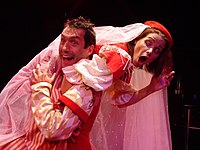The Taming of the Shrew (Shebalin)
The Taming of the Shrew (Russian Ukroshchenye stroptivoy, Cyrillic Укрощение строптивой) is a 1957 opera in four acts, five scenes by Vissarion Shebalin to a libretto by the Soviet musicologist Abram Akimovich Gozenpud, based on the comedy by William Shakespeare. Gozenpud utilized very little of Shakespeare's original text in his libretto, and completely eliminated many of the secondary characters and subplots from the play. His libretto does match the spirit of Shakespeare's play in its use of wit, the genuine passion of the story's lovers, and mixture of both lofty and coarse language.[1]
Performance history
Ukroshcheniye stroptivoy had its world premiere in a concert version at the Central House of Artists in Moscow on 1 October 1955.[1] The opera was first staged at the Samara Opera and Ballet Theatre (then known as the Kuybïshev Opera) on 25 May 1957 under the baton of conductor S. S. Bergolts. Unhappy with the final scene between Katherine and Petruchio, Shebalin completely re-wrote the ending of the opera for the work's first staging at the Bolshoi Theatre in August 1957.[1] In subsequent months the work was performed in Leningrad, Kiev and other cities.[2][3]
The success of the opera enabled Shebalin to be partly rehabilitated[4] and is considered by some Russian musicologists the "most successful Russian opera based on Shakespeare."[5] The music is in a traditional high-spirited opera buffa idiom.[6]
Roles
| Role | Voice type | |
|---|---|---|
| Katarina, eldest daughter of Baptista Minola | soprano | |
| Petruchio, a gentleman of Verona | baritone | |
| Liuchentsio, suitor of Bianca | tenor | |
| Gortenzio, suitor of Bianca | bass | |
| Bianka, younger daughter of Baptista Minola | soprano | |
| Baptista Minola, a rich merchant | bass | |
| Biondello, servant of Baptista Minola | tenor | |
| Curtis, servant of Petruchio | tenor | |
| Groom, servant of Petruchio | bass | |
| A tailor | tenor | |
| Chorus of guests, servants, cooks and kitchen maids. | ||
Plot
Bianka, the youngest daughter of Paduan merchant Baptista Minola, has won the hearts of two young noblemen, Liuchentsio and Gortenzio, who are in competition for her affections. However, Baptista will not allow his youngest daughter to marry until his oldest daughter, the tempestuous Katerina, has married. The two young nobleman conspire together to marry off Katerina so they may freely compete for Bianca. The two men recruit Hortensio's visiting friend, the Verona nobleman Petruchio, to be Katarina's suitor. All does not go well at first, but by the opera's conclusion Petruchio and Katarina are happily in love and married.[1]
Recordings
The 1957 Bolshoi performance under Zdeněk Chalabala with Galina Vishnevskaya as Caterina, Yevgeny Kibkalo as Petruchio, Glafira Deomidova as Bianca and Arthur Eisen as Baptista, was recorded for radio and issued in 1961 on LP by Melodiya.[7][8]
References
- ^ a b c d *Fay, Laurel, "Ukroshcheniye stroptivoy", Grove Music Online ed. L. Macy (Accessed October 11, 2015), (subscription access)
- ^ Belcanto.ru article by M. Druskin Опера Виссариона Шебалина «Укрощение строптивой» М. Друскин
- ^ Опера Виссариона Шебалина «Укрощение строптивой» Soviet Music Lexicon entry, coincidentally written by the librettist himself, Abram Gozenpud.
- ^ Music and Musical Life in Soviet Russia, 1917–1970: Volume 1972, Part 2. Boris Schwarz – 1972 "Another work by an older master – Shebalin – achieved a notable success: The Taming of the Shrew. It was not only a matter of recognizing its musical excellence but also of rehabilitating a composer who had suffered grave injustice."
- ^ Yuri Abdokov – essay Vissarion Shebalin and his cappella choral cycles, Toccata Classics 2011
- ^ Shakespeare Survey – p. 87, Allardyce Nicoll – 2002 "A more successful opera, based on an adaptation rather than a translation, is The Taming of the Shrew by the Russian Shebalin. Though produced as recently as 1957, this uses a thoroughly old-fashioned traditional idiom; but at least it hitches on to an appropriate tradition, that of opera buffa, and it translates into music a good deal of the high spirits of the play."
- ^ Зденек Халабала (Zdeněk Chalabala) "...а также сделанная в СССР запись оперы В. Шебалина «Укрощение строптивой»."
- ^ Recordings of three works based on The Taming of the Shrew: Shebalin; Hermann Goetz: Der Widerspänstigen Zähmung; Vicente Martín y Soler: La capricciosa corretta

